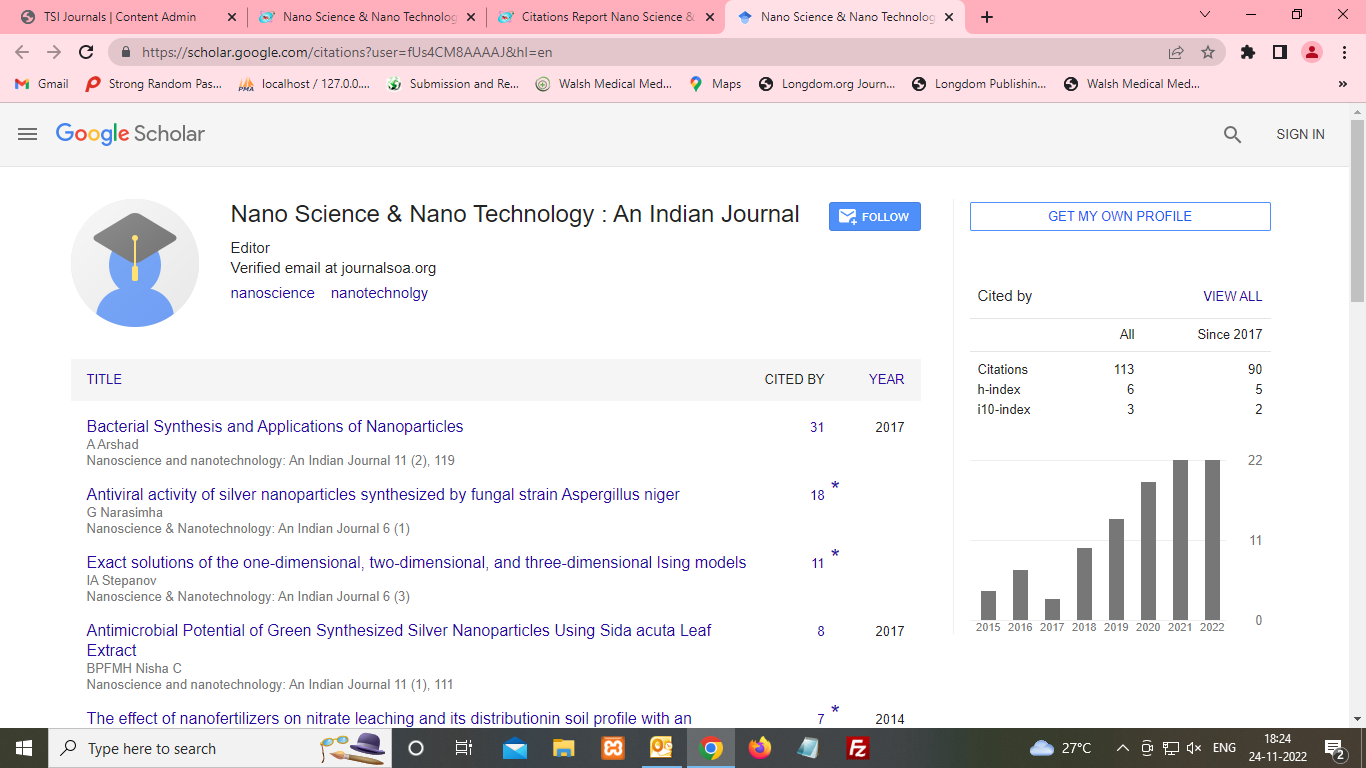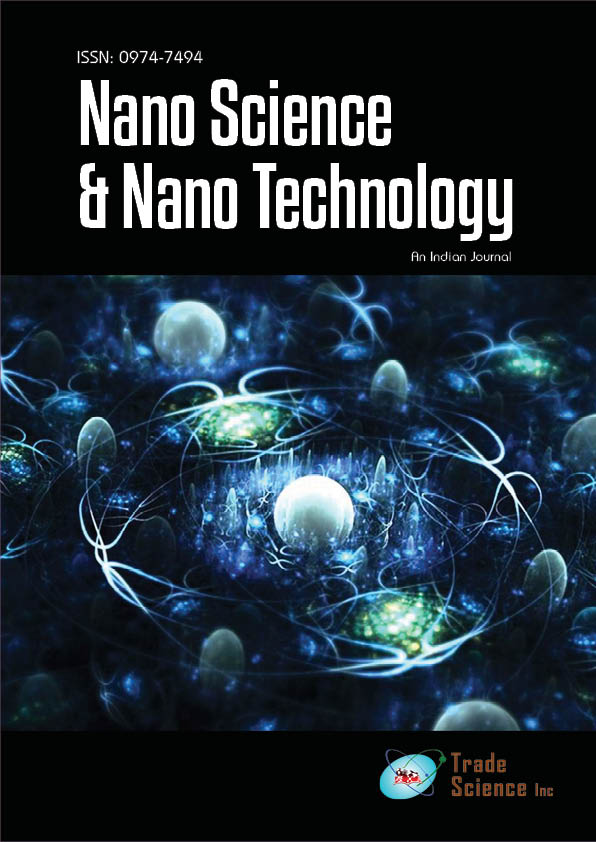Editorial
, Volume: 16( 2) DOI: 10.37532/ 0974-7419.2022.16(2).150Supramolecular Chemistry: An Overview
Citation:Thomson L. Supramolecular Chemistry: An Overview. Nano Tech Nano Sci Ind J. 2022; 16(2):150. ©2022 Trade Science Inc.
Abstract
The study of molecular recognition and high-order assemblages created by noncovalent interactions is the subject of supramolecular chemistry, sometimes known as "chemical beyond the molecule." Donald J. Cram, Jean-Marie Lehn, and Charles J. Pedersen were jointly awarded the Nobel Prize in Chemistry in 1987 "for their creation and application of compounds having structure-specific interactions of great selectivity." Supramolecular chemistry became a well-known chemical subject as a result of this. Supramolecular systems can respond to stimuli because they are made up of building pieces connected together by noncovalent interactions. Furthermore, intriguing chemical designs that are difficult to build using covalent chemistry, such as rotaxanes, catenanes, and knots, may be easily synthesized using templated synthesis. Supramolecular chemistry has been intensively investigated in a variety of domains, including molecular machines, molecular sensors, gas absorption, nanoreactors, chemical catalysis, and drug delivery, after just around 50 years of study. Supramolecular chemistry is therefore a combination of organic chemistry, physical chemistry, coordination chemistry, polymer chemistry, materials science, biology, and other disciplines.Keywords
Celosia; Drought stress; DUF538; Gene expression; Real-Time PCR
Introduction
The study of molecular recognition and high-order assemblages created by noncovalent interactions is the subject of supramolecular chemistry, sometimes known as "chemical beyond the molecule." Donald J. Cram, Jean-Marie Lehn, and Charles J. Pedersen were jointly awarded the Nobel Prize in Chemistry in 1987 "for their creation and application of compounds having structure-specific interactions of great selectivity." Supramolecular chemistry became a well-known chemical subject as a result of this. Supramolecular systems can respond to stimuli because they are made up of building pieces connected together by noncovalent interactions.
Furthermore, intriguing chemical designs that are difficult to build using covalent chemistry, such as rotaxanes, catenanes, and knots, may be easily synthesized using templated synthesis. Supramolecular chemistry has been intensively investigated in a variety of domains, including molecular machines, molecular sensors, gas absorption, nanoreactors, chemical catalysis, and drug delivery, after just around 50 years of study. Supramolecular chemistry is therefore a combination of organic chemistry, physical chemistry, coordination chemistry, polymer chemistry, materials science, biology, and other disciplines.
Supramolecular architectures
A major percentage of supramolecular structures are produced to execute activities and tasks based on host-guest interactions and the self-assembling process. Zhang, for example, is interested in supramolecular polymers made through the self-assembly of tiny molecules. Supramolecular amphiphiles based on host-guest molecular recognition motifs are highlighted by Huang. Liu demonstrates how chiral supramolecular ensembles are built. Supramolecular assemblages are generally stimuli-responsive due to their dynamic features, which can be useful in a variety of applications. Tung and Yang talk about energy-efficient self-assemblies and their bioapplications. Tian explains how photoresponsive host-guest functional systems work. Yam discusses d8 and d10 transition metal-based light-emitting self-assembled materials. Nitschke is interested in metal-ligand assemblages that respond to stimuli. Based on host-guest interactions, Zhao highlights biomedical applications of supramolecular systems.
Supramolecular analytical chemistry is a new study topic that combines supramolecular chemistry with analytical chemistry. It is primarily concerned with the development and deployment of sensors. You and Anslyn discuss new developments in supramolecular analytical chemistry based on optical sensing.
Meanwhile, Kim discusses chromogenic/fluorogenic ensemble chemosensing devices. Yoon gives an overview of advancements in the field of gas chemosensors.
Hydrophobic and solvation effects of pi-pi interactions
Supramolecular chemistry, chemistry that extends beyond the molecule is heavily reliant on the system's cumulative weak force interactions. The intensity of these forces is determined by their nature, directionality, steric factors, and other subtle characteristics that have been researched extensively over the last century. Many of these interactions are well recognized, and receptors built around them frequently fulfill their objectives. What's more bothersome is how the solvent will influence the conformations of the host and/or guest, as well as how the solvent will affect their accessibility to one another.
When the complex arises, the host and visitor will experience a major change in the solvent organization. When host+guest are complicated, the change in S is frequently uncertain. When attempting to characterize drug-receptor interactions, the same problems arise. In the world of supramolecular chemistry, the least polar liquids have the strongest binding strengths. Aqueous systems applications have become increasingly important as the discipline has grown in relevance.
Pi–pi interactions are a good example of a weak interaction that can be affected by solvation effects. Of course, in arenes like nitrobenzene–anisole, there occurs a dipolar contact of the pi-acid to pi-base type. Because there is no strong dipolar connection between arenes like benzene, stabilization (G) may be caused by solvent exclusion, which affects S rather than any major enthalpic interaction. Pi-pi interactions have been widely researched in recent years. Van der Waals connections are linked to solvation complexity and receptors that make excellent use of them.
References
- Hope MJ, Wong KF, Cullis PR. Freeze fracture of lipids and model membrane systems. J electron microsoc. 1989; 13(4):277- 287.
- Dubochet J, Mcdowell AW. Frozen aqueous suspensions. Ultramicroscopy.1982; 10(1): 55-61
- Friedrich H, Sommerdijk. Imaging of self-assembled structures: interpretation of Tem and cryo-tem images. Angew. Chem. Int. Ed. 2010; 49(43): 7850-8
- Talmon Y. transmission electron microscopy of complex fluids: the state of the art. Ber. Bunsen. Ges. Phys. Chem. Chem. phys. 1996;100(3):364-72
- Cui H, Hodgdon TK, Kaler EWet al. Elucidating the assembled structure of amphiphiles in solution via cryogenic transmission electron microscopy. Soft Matter. 2007;3(8):945-55.

